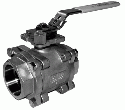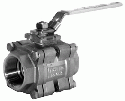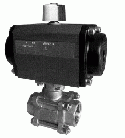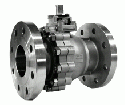Ball Valves
Ball Valves | About Ball Valves?
Ball Valves are used in a wide variety of application throughout the world.
They are one of the most popular types of valves on the planet because they are cheap to buy,
cheap to own, and easy to install. Consequently we find ball valves used in applications ranging
from chemical manufacturing all the way down to residential plumbing.
Standard Ball Valves are ideal for on/off service in small diameter pipes where tight flow control is not a requirement. However, there are many variations of ball valves that provide better flow profiles when used in flow control applications. The most common variation is known as a V-Ball which incorporated a ball with a "V" cut into the center of the ball rather than a standard circle.
A V-Ball used in combination with a valve actuator and a valve positioner can provide good flow control for various applications. A typical setup would require a pneumatic valve actuator which can use either air-to-open / air-to-close, air-to-open / spring-to-close, or spring-to-open / air-to-close. The valve positioner can except a variety of input signals ranging from 4/20mA, FieldBus, Profibus, etc. in order to control the amount of air sent to the pneumatic valve actuator. So, in order to make this style of automated ball valve work, you'll need a pneumatic air supply coming from an air compressor and an input signal from a PLC or DCS System.
Standard Ball Valves are ideal for on/off service in small diameter pipes where tight flow control is not a requirement. However, there are many variations of ball valves that provide better flow profiles when used in flow control applications. The most common variation is known as a V-Ball which incorporated a ball with a "V" cut into the center of the ball rather than a standard circle.
A V-Ball used in combination with a valve actuator and a valve positioner can provide good flow control for various applications. A typical setup would require a pneumatic valve actuator which can use either air-to-open / air-to-close, air-to-open / spring-to-close, or spring-to-open / air-to-close. The valve positioner can except a variety of input signals ranging from 4/20mA, FieldBus, Profibus, etc. in order to control the amount of air sent to the pneumatic valve actuator. So, in order to make this style of automated ball valve work, you'll need a pneumatic air supply coming from an air compressor and an input signal from a PLC or DCS System.
Ball Valves | Ball Valve Actuation
The advantages of pneumatic control valves are numerous and include low maintenance, high speed actuation,
and low operating costs. Pneumatic actuation is also preferred in explosive environments where it is difficult to
safely run high voltage electricity.
The other popular method of automating ball valves is using an electric actuator. Electric actuators work in a very similar fashion to pneumatic actuators except they require a high voltage electrical current to move the valve rather than an air supply. Many times people do not have a pneumatic air supply available, but they do have electricity near a ball valve. Obviously in this situation an electric actuator may be preferred over a pneumatic actuator. Electric ball valve actuators also provide some unique advantages over their pneumatic counterparts.
Electric ball valve actuators close the ball valve in a very slow and controlled fashion which reduces hammer on the pipes and decreases fast, unintended process changes. Typically electric actuators do not contain springs like pneumatic actuators and therefore do not fail-closed or fail-open if they loose power. Normally if an electric actuator looses power it will maintain it's current position with enough torque that the valve will not move.
Electric ball valve actuators can also include a valve positioner which works very similar to the positioners used for pneumatic ball valve actuators. These valve positioners can except a 4/20mA, FieldBus, Profibus, etc. input signal and appropriately adjust the position of the valve. As the valve position changes so does the amount of product allowed through the ball valve.
The other popular method of automating ball valves is using an electric actuator. Electric actuators work in a very similar fashion to pneumatic actuators except they require a high voltage electrical current to move the valve rather than an air supply. Many times people do not have a pneumatic air supply available, but they do have electricity near a ball valve. Obviously in this situation an electric actuator may be preferred over a pneumatic actuator. Electric ball valve actuators also provide some unique advantages over their pneumatic counterparts.
Electric ball valve actuators close the ball valve in a very slow and controlled fashion which reduces hammer on the pipes and decreases fast, unintended process changes. Typically electric actuators do not contain springs like pneumatic actuators and therefore do not fail-closed or fail-open if they loose power. Normally if an electric actuator looses power it will maintain it's current position with enough torque that the valve will not move.
Electric ball valve actuators can also include a valve positioner which works very similar to the positioners used for pneumatic ball valve actuators. These valve positioners can except a 4/20mA, FieldBus, Profibus, etc. input signal and appropriately adjust the position of the valve. As the valve position changes so does the amount of product allowed through the ball valve.
Ball Valves | Ball Valve Options
Ball Valves are also available in a variety of materials making them compatible with a variety of process materials.
Typical materials of construction include brass, bronze, cast iron, stainless steel, steel, plastics, etc. The internal
seats of a ball valve also come in a variety of materials including PTFE Telfon, steel, buna, viton, etc. All of these
options exist in order to give you the ability to match the "wetted material" (materials coming in contact with the
process medium) with compatible material giving the valve the longer service life.
Ball Valves are also available with a variety of process connections including threaded process connections, socket weld process connection, flanged process connections, sanitary process clamps, etc. Depending on your application, budget, service needs, etc. you can decide on one of these available process connections.
Ball Valves are also available in a variety of body styles including one piece, two piece, three piece, etc. The body style typically dictates how easy it is to maintain and replace the valve once it is in service. For example, a three piece ball valve enables you to remove the body of the valve from rigid pipe replacing the ball, stem, seats, etc.
Ball Valves typically range in sizes between 1/4" up to 6". Ball valves are normally not price effective above 6" in size and require additional support due to their heavy weight in larger sizes. Consequently people tend to use Butterfly Valves, or another style of valve in larger pipes.
Ball Valves are also available with a variety of process connections including threaded process connections, socket weld process connection, flanged process connections, sanitary process clamps, etc. Depending on your application, budget, service needs, etc. you can decide on one of these available process connections.
Ball Valves are also available in a variety of body styles including one piece, two piece, three piece, etc. The body style typically dictates how easy it is to maintain and replace the valve once it is in service. For example, a three piece ball valve enables you to remove the body of the valve from rigid pipe replacing the ball, stem, seats, etc.
Ball Valves typically range in sizes between 1/4" up to 6". Ball valves are normally not price effective above 6" in size and require additional support due to their heavy weight in larger sizes. Consequently people tend to use Butterfly Valves, or another style of valve in larger pipes.
Threaded End Connections (NPT)
10 products
Socket Weld End Connections
6 products
Sanitary End Clamp & Tube Ends
2 products
Flanged End Connection
6 products
Multi-Port 3 & 4 Way
4 products
Tank Bottom Valve
1 products

Products
Ball Valve: Flo-Tite 200-CS
• Multi-Choice Series
• 3pc Full Port
• Carbon Steel
• Threaded Connections
• 1500 WOG
Valve - Technical Documentation
• 3pc Full Port
• Carbon Steel
• Threaded Connections
• 1500 WOG
Valve - Technical Documentation
Our price: $33.60
Market price: $70.00
save 52%
Ball Valve: Flo-Tite 300-SS
• Multi-Choice Series
• 3pc Full Port
• Stainless Steel
• Threaded Connections
• 1500 WOG
Valve - Technical Documentation
• 3pc Full Port
• Stainless Steel
• Threaded Connections
• 1500 WOG
Valve - Technical Documentation
Our price: $45.60
Market price: $95.00
save 52%
Ball Valve: Flo-Tite 350SS
• Multi-Choice Sanitary Series
• 3pc True Bore
• Stainless Steel
• Clamp Ends
Valve - Technical Documentation
• 3pc True Bore
• Stainless Steel
• Clamp Ends
Valve - Technical Documentation
Our price: $67.20
Market price: $140.00
save 52%
Ball Valve: Flo-Tite 370SS
• Multi-Choice Sanitary Series
• 3pc True Bore
• Stainless Steel
• Extended Tube Ends
Valve - Technical Documentation
• 3pc True Bore
• Stainless Steel
• Extended Tube Ends
Valve - Technical Documentation
Our price: $72.00
Market price: $150.00
save 52%
Ball Valve: Flo-Tite 410CS
• Tri-Star Series
• 3pc Full Bore
• Carbon Steel
• Threaded Connections
• 1500 CWP / 150 SWP
Valve - Technical Documentation
• 3pc Full Bore
• Carbon Steel
• Threaded Connections
• 1500 CWP / 150 SWP
Valve - Technical Documentation
Our price: $29.28
Market price: $61.00
save 52%
Ball Valve: Flo-Tite 420CS
• Tri-Star Series
• 3pc Full Bore
• Carbon Steel
• Socket Weld Connections
• 1500 CWP / 150 SWP
Valve - Technical Documentation
• 3pc Full Bore
• Carbon Steel
• Socket Weld Connections
• 1500 CWP / 150 SWP
Valve - Technical Documentation
Our price: $29.28
Market price: $61.00
save 52%
Ball Valve: Flo-Tite 510SS
• Tri-Star Series
• 3pc Full Bore
• Stainless Steel
• Threaded Connections
• 1500 CWP / 150 SWP
Valve - Technical Documentation
• 3pc Full Bore
• Stainless Steel
• Threaded Connections
• 1500 CWP / 150 SWP
Valve - Technical Documentation
Our price: $40.32
Market price: $84.00
save 52%
Ball Valve: Flo-Tite 520SS
• Tri-Star Series
• 3pc Full Bore
• Stainless Steel
• Socket Weld Connections
• 1500 CWP / 150 SWP
Valve - Technical Documentation
• 3pc Full Bore
• Stainless Steel
• Socket Weld Connections
• 1500 CWP / 150 SWP
Valve - Technical Documentation
Our price: $40.32
Market price: $84.00
save 52%
Ball Valve: Flo-Tite DM310SS
• Direct-Mount Automation Series
• 3pc Full Port
• Stainless Steel
• Threaded Connections
Valve - Technical Documentation
• 3pc Full Port
• Stainless Steel
• Threaded Connections
Valve - Technical Documentation
Our price: $35.52
Market price: $74.00
save 52%
Ball Valve: Flo-Tite F150-CS
• Full-Flo Series
• 2pc Full Bore
• Carbon Steel
• ANSI 150 Flange Connections
Valve - Technical Documentation
• 2pc Full Bore
• Carbon Steel
• ANSI 150 Flange Connections
Valve - Technical Documentation
Our price: $85.44
Market price: $178.00
save 52%












